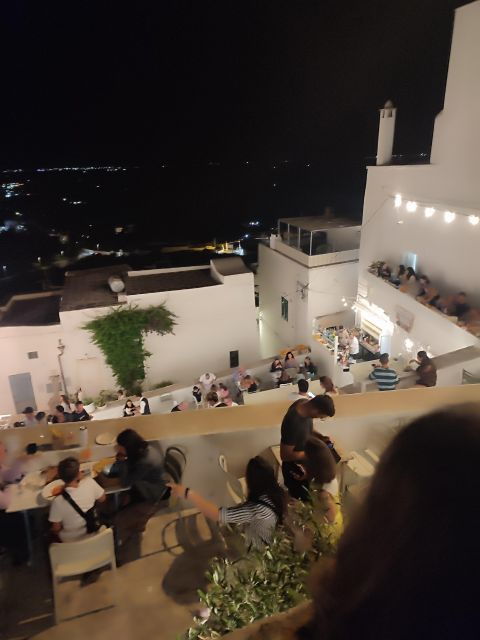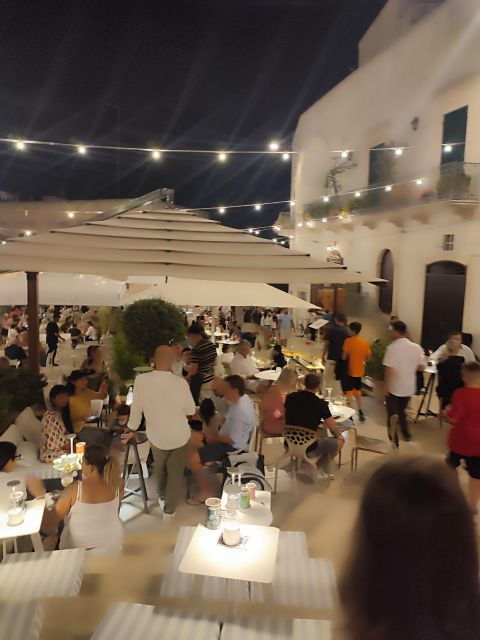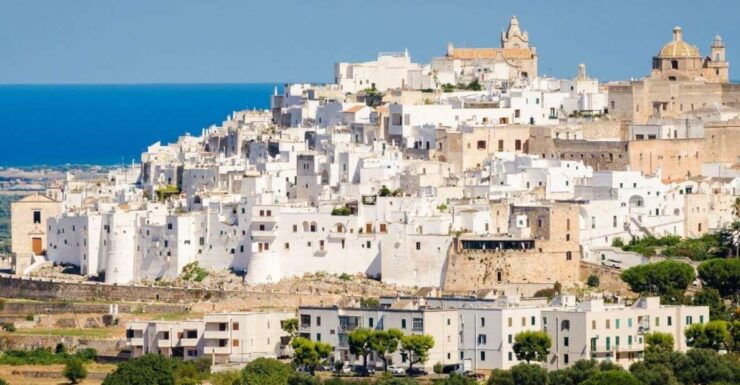Nestled in the heart of Apulia, Italy, Ostuni, known as ‘The White City,’ boasts a history as fascinating as its pristine white facades. A testament to the city’s enduring allure, Ostuni’s past is a tapestry woven with influences from multiple civilizations, each leaving their mark on the city’s streets and structures.
But what is it about Ostuni’s white buildings that make them more than just architectural marvels? There’s a deeper symbolism waiting to be uncovered, a story of purity and tranquility that beckons exploration into the history of this captivating city.
Good To Know

- Ostuni, known as ‘The White City,’ reflects traditional Apulian architecture with its white buildings.
- The city’s white buildings symbolize purity, peace, and serve practical purposes like reflecting sunlight.
- Ostuni’s history dates back to the Middle Ages, blending various cultural influences over time.
- Preservation efforts are in place to maintain Ostuni’s charm, attracting visitors for its unique cultural and architectural heritage.
Origins of Ostuni

The origins of Ostuni, a city steeped in history and cultural significance, can be traced back to the Middle Ages when its captivating journey began. Founded during medieval times, Ostuni’s roots delve deep into the past, shaping its unique character and charm.
The city’s cultural evolution over the centuries has been influenced by various civilizations, leaving a rich tapestry of traditions and architectural wonders for visitors to explore. The narrow streets and white buildings that define Ostuni’s landscape not only showcase traditional Apulian architecture but also symbolize purity and peace.
As Ostuni continues to preserve its heritage, travelers can enjoy the medieval origins and witness firsthand the enchanting blend of history and culture that define this remarkable city.
Interested in history? More Ostuni historical sites we've covered
Influence of Various Civilizations

How have past civilizations shaped the cultural tapestry of Ostuni, the captivating ‘White City’ of Italy? Throughout the Middle Ages, Ostuni has been influenced by a myriad of civilizations, each leaving a unique mark on its architectural landscape.
Byzantine Empire: Byzantine architectural influences can be seen in the intricate detailing and ornate designs found in some of Ostuni’s historical buildings.
Norman Conquest: The Norman Conquest introduced elements of fortress-like structures and defensive walls, evident in the fortified areas of the city.
Aragonese Dynasty: The Aragonese Dynasty contributed to the development of grand palaces and noble residences, showcasing a blend of Gothic and Renaissance styles.
Ottoman Empire: Ottoman architectural influences can be observed in the design of certain mosques and public buildings, reflecting a fusion of Eastern and Western aesthetics.
Traditional Apulian Architecture
Influenced by a myriad of civilizations throughout history, Ostuni’s captivating ‘White City’ showcases a unique blend of traditional Apulian architecture. The origins of this architectural style can be traced back to the ancient Messapii and Greeks who settled in the region, gradually evolving over centuries.
The evolution of traditional Apulian architecture is evident in the iconic whitewashed buildings with flat roofs, domed ceilings, and narrow streets that characterize Ostuni. These architectural features not only reflect the climatic needs of the region but also symbolize purity and peace.
Preservation efforts play a crucial role in maintaining the charm and authenticity of Ostuni’s architectural heritage, attracting visitors from around the world to experience the allure of this historic ‘White City.’
Symbolism of White Buildings
Elegantly standing against the azure skies, Ostuni’s white buildings radiate a timeless symbolism of purity and tranquility. The color psychology and architectural significance of these structures blend seamlessly with the cultural symbolism and urban design of the city. Here is a glimpse of what makes Ostuni’s white buildings so captivating:
Color Psychology: The white hue evokes a sense of cleanliness and simplicity, creating a serene atmosphere.
Architectural Significance: The choice of white reflects traditional Apulian architecture, highlighting the region’s historical roots.
Cultural Symbolism: White symbolizes peace and spirituality, resonating with Ostuni’s rich cultural heritage.
Urban Design: The uniformity of white buildings contributes to the city’s aesthetic charm, offering a cohesive and picturesque cityscape.
Preservation Efforts and Charm
With a commitment to preserving its historical allure, Ostuni’s charm is safeguarded through dedicated conservation efforts. Preservation initiatives ensure the continued beauty of Ostuni’s architectural heritage, maintaining the city’s unique appeal for generations to come. The white buildings, a hallmark of Ostuni, are not only aesthetically pleasing but also play a crucial role in reflecting the city’s cultural identity. These efforts highlight the importance of protecting Ostuni’s architectural beauty, allowing visitors to enjoy the rich history and atmosphere of the white city.
| Preservation Initiatives | Architectural Beauty |
|---|---|
| Historical Restoration | Traditional Designs |
| Maintenance Programs | Unique Structures |
| Cultural Heritage | Aesthetic Appeal |
| Conservation Projects | Timeless Elegance |
| Community Involvement | Symbolic Significance |
Location in Apulia, Italy
Nestled in the heart of Apulia, Italy, Ostuni captivates visitors with its timeless charm and rich cultural heritage. The city’s location in the region of Apulia offers a unique blend of cultural traditions and architectural highlights, making it a must-visit destination for travelers.
- Cultural traditions: Ostuni showcases a mix of influences from various civilizations, enriching its cultural tapestry.
- Architectural highlights: The city’s narrow streets and white buildings reflect traditional Apulian architecture, creating a picturesque setting.
- Rich history: Ostuni’s Middle Ages origins contribute to its historical significance and allure.
- Preservation efforts: Conservation initiatives are in place to safeguard Ostuni’s unique charm for future generations to enjoy.
Tourist Attractions and Experiences
Drawing travelers from all corners of the globe, Ostuni offers a captivating array of tourist attractions and experiences that showcase its rich cultural heritage and historical significance. The city’s unique charm lies in its white buildings and narrow streets, reflecting traditional Apulian architecture.
Visitors are presented with abundant photo opportunities to capture the beauty of the whitewashed city against the backdrop of the azure sky. Enjoy Ostuni’s rich cultural heritage as you explore the historic center, visit the Cathedral of Ostuni, and meander through the old town.
Ideal for history and architecture enthusiasts, Ostuni promises a picturesque and culturally enriching travel experience, where every corner reveals a piece of its fascinating past.
Common Questions
Are There Any Specific Festivals or Events Held in Ostuni That Tourists Should Be Aware Of?
Tourists visiting Ostuni should enjoy cultural celebrations, local art, traditional music, and culinary experiences. The city hosts vibrant festivals throughout the year, offering a perfect blend of traditions and flavors for visitors to enjoy.
What Are Some Lesser-Known Local Dishes or Specialties That Visitors Should Try While in Ostuni?
Visitors to Ostuni should explore the local delicacies and authentic cuisine for a culinary exploration. Discover traditional flavors that capture the essence of the region, offering a unique and flavorful experience.
Are There Any Hidden Gems or Off-The-Beaten-Path Attractions in Ostuni That Are Worth Exploring?
Hidden gems and off-the-beaten-path attractions in Ostuni offer unique experiences. Visitors can discover secluded beaches, ancient olive groves, and charming local markets. These hidden treasures provide a glimpse into the authentic and serene side of the White City.
What Is the Best Way to Interact With the Local Community and Learn About Their Traditions and Way of Life?
To learn about local traditions and immerse in culture, engage with the community. Seek learning opportunities by participating in traditional events, visiting local markets, and interacting with residents. This hands-on approach fosters a deeper understanding of their way of life.
How Has Modernization and Tourism Impacted the Traditional Way of Life in Ostuni, and What Efforts Are Being Made to Preserve the City’s Cultural Heritage Amidst These Changes?
Modernization and tourism have altered Ostuni’s traditional way of life, impacting its cultural heritage. Efforts to preserve the city’s essence amidst these changes include promoting sustainable tourism, restoring historical sites, and educating locals and visitors on the importance of cultural preservation.
The Sum Up
Experience the enchanting allure of Ostuni, ‘The White City,’ where history, culture, and architecture intertwine to create a truly mesmerizing destination in Apulia, Italy.
As you wander through the narrow streets and admire the white buildings that reflect sunlight and symbolize purity, you’ll be transported back in time to a place where preservation efforts ensure that the charm and beauty of Ostuni remain timeless.
Enjoy the history and culture of this unique city for an unforgettable travel experience.
You can check if your dates are available here:More Historical Tours in Ostuni
More Tour Reviews in Ostuni
Looking for something different? Other Ostuni activities we've written about
- Apulian Food Experience: discovering the flavors of Apulia.
- Guided visit to the Medieval Gardens of Ostuni
- In the white of Ostuni
- Ostuni organic wines – tour and tasting in the winery
- Walk and Aperitif in the Secret Gardens of Ostuni
- EVO Experience: discovering Pomes oil
- Ostuni: cooking class of fried panzerotti and puccitedde
- Ostuni: cook pasta with local family in the countryside!
- Full-Day Tour Gallipoli, Galatina & Otranto
- Brindisi: Alberobello, Locorotondo & Ostuni Tour With Brunch
- Ostuni the History of White
- 3 Best Wine Tours In Ostuni
